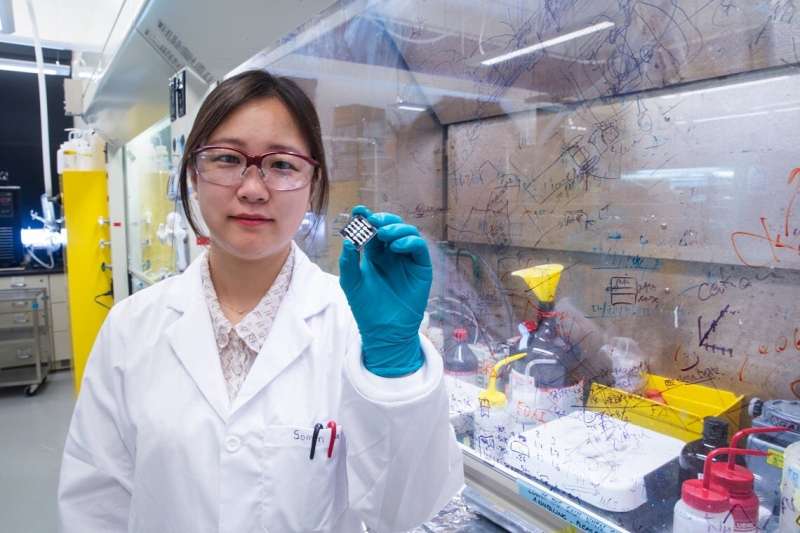This article has been reviewed according to Science X's editorial process and policies. Editors have highlighted the following attributes while ensuring the content's credibility:
fact-checked
peer-reviewed publication
trusted source
proofread
Improved stability could help perovskite solar cells compete with silicon

An international team that includes researchers from the University of Toronto's Faculty of Applied Science & Engineering has created a perovskite solar cell that can stand up to high temperatures for more than 1,500 hours—a key milestone as this emerging technology moves closer to commercial application.
The team's findings were recently published in the journal Science.
"Perovskite solar cells offer new pathways to overcome some of the efficiency limitations of silicon-based technology, which is the industrial standard today," says Ted Sargent, a University Professor in the Edward S. Rogers Sr. department of electrical and computer engineering who recently joined the departments of chemistry and electrical and computer engineering at Northwestern University.
"But due to its multi-decade head start, silicon still has an advantage in some areas, including stability. This study shows how we can close that gap."
Traditional solar cells are made of high-purity silicon wafers that are energy-intensive to produce. In addition, they can only absorb certain parts of the solar spectrum.
By contrast, perovskite solar cells are made of layers of nanoscale crystals, making them more amenable to low-cost manufacturing methods. By adjusting the size and composition of these crystals, researchers can also tune the wavelengths of light they absorb.
It is also possible to deposit perovskite layers on top of each other, or even on top of silicon solar cells, enabling them to use more of the solar spectrum and further increase their efficiency.
Over the past few years, advances from Sargent's lab and others have brought the efficiency of perovskite solar cells to within the same range as what is achievable with silicon. However, the challenge of stability has received comparatively less attention.
"We wanted to work at high temperatures and high relative humidity, because that would give us a better idea of which components might fail first, and how to improve them," says So Min Park, a postdoctoral fellow in Sargent's lab and one of three co-lead authors on the study.
"We combined our expertise in materials discovery, spectroscopy and device fabrication to design and characterize a new surface coating for the surface of the perovskites. Our data showed that it is this coating, made with fluorinated ammonium ligands, that enhances the stability of the overall cell."
Perovskite solar cells typically contain a passivation layer, which surrounds the light-absorbing perovskite layer and acts as a conduit for electrons to move into the surrounding circuit.
But depending on its composition, as well as its exposure to heat and humidity, the passivation layer can deform in ways that impede the flow of electrons.
"Many groups use passivation layers made with bulky ammonium ions, a nitrogen-containing organic molecule," says Mingyang Wei, a Ph.D. graduate from the department of electrical and computer engineering who is currently a postdoctoral fellow at École Polytechnique Fédérale de Lausanne and co-lead author on the paper.
"Even though they form stable 2D structures at room temperature, these passivation layers can degrade at elevated temperatures, due to their intermixing with underlying perovskites. What we did was replace typical ammonium ions with 3,4,5-trifluoroanilinium. This new passivation layer does not intercalate into the structure of the perovskite crystals, making it thermally stable."
The team then tested the performance of the cells using continuous measurements at a temperature of 85 Celsius, a relative humidity of 50 percent, maximum power-point tracking and an illumination equivalent to full sunlight. In the paper, they report a T85—the amount of time it takes for the cell's performance to degrade to 85 percent of its original value—of 1,560 hours.
"A typical value for a perovskite cell like this would be more like 500 hours," Park says. "There are some teams who have reported measurements of more than 1,000 hours, but not at temperatures as high as this. Our design is a big improvement, and we were really excited to see that it worked this well."
Park says the team's passivation layer could be combined with other innovations, such as double- or triple-junction designs, to further enhance perovskite solar-cell performance.
"We still have a long way to go before we can fully replicate the performance of silicon, but the progress in this field has been very rapid over the last few years," she says.
"We're moving in the right direction, and this study will hopefully point the way forward for others."
More information: So Min Park et al, Engineering ligand reactivity enables high-temperature operation of stable perovskite solar cells, Science (2023). DOI: 10.1126/science.adi4107
Journal information: Science
Provided by University of Toronto





















